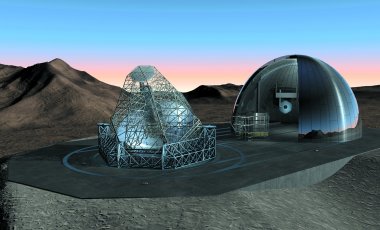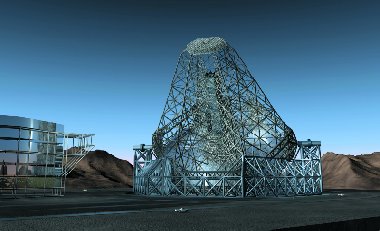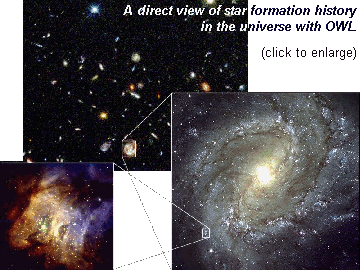|
|
|
 Last
modified: 2006/04/13 Last
modified: 2006/04/13
| OWL
- a future milestone for Astronomy? |
| |
A
100-M CLASS OPTICAL AND NEAR-INFRARED TELESCOPE |
|
|

|
OWL will operate
in open air and be covered by a sliding enclosure during
daytime.
|
Building on the success of its 8-m Very Large Telescope (VLT)
and the coming to maturity of controlled optical systems,
ESO has studied the concept of a giant, next generation
optical and near-infrared telescope, dubbed OWL for for the
eponymous bird's keen night vision, and for OverWhelmingly
Large (an implied reference to astronomer's taste for
bold names such as Very Large Telescope, Extremely
Large Telescope, etc.)
With a diameter of 100 meter, OWL would combine unrivalled
light gathering power with the ability to resolve details
down to a milli-arc second.
 |
|
A
crude simulation showing images of the same object as
seen by existing facilities and by OWL. OWL angular
resolution will be 40 times better than that of the
Hubble Space Telescope.
(Click to enlarge)
|
|
|
With the present generation of 8 to 10 m class telescopes
well along the way, a number of astronomical Institutions
are now starting to work towards the next generation of Extremely
Large Telescopes (ELT). Detailed Science Studies have shown
that giant collectors - 25-m diameter up- working near their
diffraction limit (a hundredth to a few thousands arc-second
on the sky) are indeed needed for the next major advances
in the knowledge of the Universe we live in.
| -- |

|
| |
OWL design relies
extensively on serially produced modules. |
| |
|
Most current ELT projects are up scaled versions of the segmented
Ritchey-Chrétien concept, successfully pioneered in
the early 90's with the twin 10-m diameter Keck telescopes
located on top of Mauna Kea, Hawaii.
Since 1997, ESO has worked in close cooperation with European
Industries on an original concept, with the goal of breaking
the steep cost to diameter law of this classical approach.
OWL relies on a paradigm change: while nearly all telescopes
in the past have been built as one-off prototypes, OWL is
based on mass production of the major cost items, notably
the overall mechanical structure with modular building blocks
(as pioneered by Gustave Eiffel in 1899 for his eponymous
tower) and spherical primary segmented mirror (pioneered by
the Hobby-Eberly Telescope in the 90s). This results in a
cheap structure, extremely light but with high performance,
as well as low-cost, yet very high quality optics.
The OWL study was completed and subsequently reviewed by an international panel of experts in the fall of 2005. Design and analysis validate
the concept as a cost-effective and time-effective way to
build any ELT significantly larger than 60m. In particular,
we found a much more hopeful cost to diameter relationship.
The review panel concurred with the soundness of the concept. However, in view of the global cost and the huge technological development needed, with significant cost and schedule risks, it recommended to study instead a less ambitious 30 - 60m facility - the European ELT.
|
| |
| OVERWHELMING
SCIENCE |
| |
 |
| OWL will provide
detailed observations of the farthest objects..
|
|
With its keen angular vision, OWL will be capable of imaging
solar system objects at resolutions comparable to that offered
by space probes, but over much longer time scales. It will
unveil the intricate processes underlying the formation of
stellar and planetary systems, not only in our own Galaxy
but also in many nearby ones.
Even more important, and in combination with its huge light
gathering power, OWL should shed light on the two major cosmic
mysteries of our time, of whether there are life-bearing planets
like our own around other Suns, and on the meaning of the
enigmatic dark matter and dark energy which in toto make up
96% of the mass content of our Universe. OWL will be able
to image exo-planets and determine their atmospheres' composition,
and thereby, possibly, reveal the existence of biospheres.
It will peer into the deepest reaches of the Universe and
witness the birth of the very first stars and galaxies. As
illustrated in the figure above and through its direct view
of star formation history back to the very first stars to
have ever exploded, it will probe the laws of physics at an
energy scale unreachable with the largest particle accelerator.
If the past history of every generation of telescope holds
true, the most important discoveries awaiting OWL could very
well happen in new, unanticipated, areas. It may, eventually,
revolutionize our perception of the Universe as much as Galileo's
telescope did.
|
| |
| A WIDE
RANGE OF SIZE |
| |
|
Although designed for 100-m diameter, OWL is a concept with
a wide range of applicability.
A preliminary analysis shows that the upper limit for the
concept is in the range of 130 meters. This limit is essentially
set by the fact that with larger diameters, monolithic relay
mirrors beyond proven dimensions (about 8-m) would probably
become necessary. In addition, safety with respect to dynamic
excitations (wind, earthquakes) and fatigue would probably
imply a structural design relying extensively on expensive
composite materials -whereas the OWL structure is made of
standard steel.
The lower size limit is in the 60-m range, below which simpler
optical solutions become attractive.
|
| |
| COMPETITIVE
COST AND TIME SCALE |
|
|
| |
|
The modular approach can break the time-honoured Time versus
Diameter law of approximately 1 year per 1-m of diameter,
which by itself would practically prohibit the construction
of any Telescope much larger than about 10-20 m. Another crucial
feature of the mass production approach is that it leads naturally
to the "growing a Telescope" scheme, with early
opening of the facility for science observations significantly
before start of full operation. Indeed, existing segmented
telescopes were already turned to the sky before the integration
of segments was complete, mainly for engineering work. With
"only" a quarter of its 3048 segments integrated,
OWL would already perform as a 50-m class telescope and thus
deliver unequalled science performance 3 to 4 years before
before full completion.
The total estimated cost of OWL is about 1,200 millions of
Euros, including 940 million Euros in capital investment.
|
| |
| INDUSTRY
AS A KEY PARTNER |
| |
|
Industry has played and is still playing a key role in ESO
projects and its involvement right from the early phases of
a new project is considered as essential. European industry
deserves substantial credit for the excellent performance
of ESO's 8m Very Large Telescopes. The VLT project has been
equally benefitial to suppliers, in the form of profitable
spin-offs or by promoting them to world-leaders in their respective
fields. In the case of OWL, the project size and its general
reliance on low-risk, serially produced components add to
the incentives for industrial participation.
The OWL concept study was supported by quite a number of industrial
studies. These studies confirm internal cost, schedule and performance
estimates, as well as the unequivocal interest of potential
suppliers to be associated with the project.
|
 |
|

